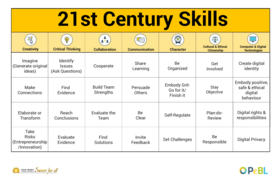Character Guidebook - K-5 (Elementary) Sun West
Character Guidebook Elementary K-5
Purpose
Why is this important?
Character is one of the 21st Century skills that students need in order to be ready to self-direct in their learning. Having the key skills that come along with strength of character allows students to be part of the planning of their instruction and assessment. In order “to use the full potential of their minds, students must learn to filter distractions and interruptions and to think deeply and critically” (Cash, 5).
Cash, Richard M.
Self-Regulation in the Classroom Helping Students Learn How to Learn:
Free Spirit Publishing, 2016
Key Steps in Teaching Character Strategies:
1. Isolate the skill needed to be taught
2. Provide students with direct teaching to learn strategies and practice self- awareness
3. Provide and allow opportunities for students to practice the skills and strategies and reflect often. This takes time at first but students are rewarded for their efforts once they are able to master their practiced skill.
4. Revisit strategies and skills often.
Explicit Teaching
To be able to learn and grow in 21st Century Competency understanding, it is important to teach each skill and let students experience what each skill looks like as well as how you can grow in each area. Caution: By simply saying the word "character, communication or collaboration...etc" students may not get a full understanding of each skill. Explicitly teaching and utilizing skills in different ways is what will ultimately promote deep understanding and growth in 21st Century Competencies.
Timeline Suggestions for Explicit Teaching
The document below provides a year plan to teach each of the 21st century skills. It is beneficial to have an explicit teaching plan to ensure each skill is taught; however skills should also be reinforced as much as possible throughout class time.
Lesson Plan Ideas
Be Organized
Why are good organizational skills necessary in everything? * They allow you to work efficiently and effectively at any task you undertake. * They reduce stress that can hinder your achievement * They buy you time and energy to reach your true potential * They allow your true talents and abilities to shine through by preventing chaos and disorder Be Organized Resources
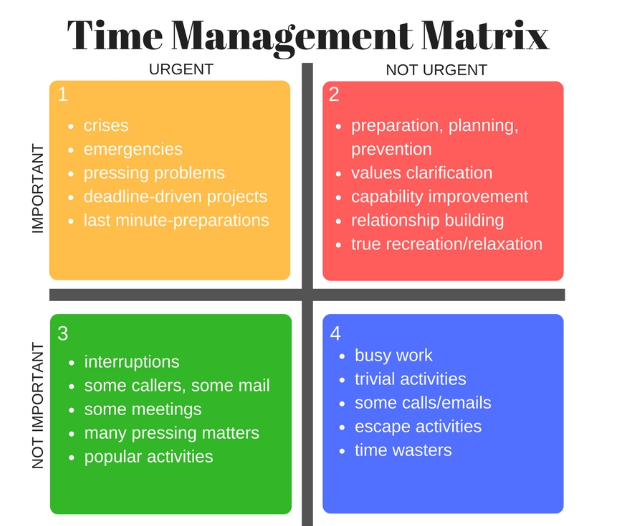
Time Management Matrix
Steps of Executive Functioning:
- Analyze a task. Figure out what needs to be done.
- Plan how to handle the task.
- Get organized. Break down the plan into a series of steps.
- Figure out how much time is needed to carry out the plan, and set aside the time.
- Make adjustments as needed
Finish the task in the time allotted.
Executive Function Strategies include:
- Eat Way Visual Timers
- Chunking Assignments
- Writing the time on their assignment when you check in on them
- Graphic Organizers
- Color code handouts
- Pictures of organized locker (a standard for students to compare too daily)
Have students use Day Planners or electronic Calendars to set appropriate timelines
Polk Elementary's ideas on why, when, how to get students organized and resources to use: http://polkdhsd7.sharpschool.com/staff_directory/p_b_s_behavior_intervention/tier_3_interventions/organizational_tools/
The why of getting organized and lesson plans for teachers: https://www.yourstoragefinder.com/why-teachers-must-invest-in-teaching-kids-organizational-skills
Tedx about Life Balance and why multi tasking doesn't work: Sara Cameron
https://www.youtube.com/watch?v=II_Qyf0Vw9g
Embody Grit - Go for it/Finish it
| Growth Mindset Activities: | |
| Class Dojo Growth Mindset Video Series | https://www.youtube.com/watch?v=2zrtHt3bBmQ&list=PL_UD9ElfNS+8NRw01pEqDuYcg4HeU2IamD |
| Carol Dweck - "The Power of Yet" | https://www.youtube.com/watch?v=J-swZaKN2Ic |
| G.R.I.T Activities: | |
| Angela Lee Duckworth - The Key to Success - Grit | https://www.youtube.com/watch?v=J-swZaKN2Ic |
| Soar - A Short Animated Video by Alice Tzue | www.youtube.com/watch?v=eDkpVwrhYfo |
| GRIT Books | |
| I Can Be Anything - Jerry Spinnely |  |
| The Magnificent Thing by Ashley Spires |  |
| Sam and Dave Dig a Hole by Mac Barnett |  |
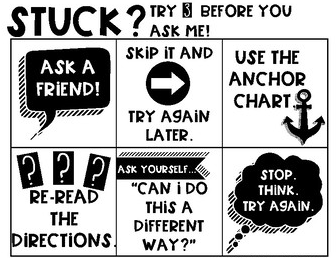
Try 3 Before You Ask Me
Self-Regulate
| Self-Regulate Websites: | |
| http://blissfulkids.com | Website teaching students about Mindfulness strategies and a simple introduction to how their brain works. |
| https://www.understood.org/en/learning-attention-issues/child-learning-disabilities/executive-functioning-issues/5-ways-kids-use-working-memory-to-learn | Self-regulation is supported by a student’s working memory. Understanding our working memory can impact how we understand why some students may struggle with some parts of self-regulation. Closely working with your SST team is beneficial. |
| https://ed.ted.com/featured/nvJHP79R | “Don’t Eat The Marshmallow” Ted Talk - Joachim de Posada about delayed gratification. Lots of replicated activities developed for classrooms. |
| http://www.brainbasedlearning.net/ |
“Brain-Based Learning”- Eric Jensen |
| Self-Regulate Books | |
| Self- Regulation in the Classroom (All Sun West schools should have this resource in their library) | |
| Alexander and The Horrible, Terrible, Very Bad Day - by Judith Voirst | |
| My Mouth was a Volcano - by Julia Cook | |
| When Sophie Gets Angry, Really, Really Angry - by Molly Bang | |
| Frog and Toad - by Arnold Lobel (4 Stories) |
|
| Pete the Cat - by James Dean (James Dean has a variety of Pete the Cat books that are all engaging for early learners.) |
|
| Scaredy Squirrel Series - by Melanie Watt |
|
Self-Regulation Games:
|
Red light, green light |
||
|
Play freeze game with hoops on the floor. Keep reducing the amounts of hoops on the floor that students have to be in when they freeze. You have to talk to them beforehand about how to all stand in one hoop together as more people have to cram into the hoop. |
||
|
Play “Conducting an Orchestra.” Teacher will be the conductor and students will all have instruments. Use a baton with movements to indicate fast, slow, stop, start. Students need to follow along with the conductor. |
||
| I know a Chicken YouTube song | https://www.youtube.com/watch?v=9E7l0JPgclE | |
| Move and Freeze YouTube song | https://www.youtube.com/watch?v=388Q44ReOWE | |
| Jack Hartman Alphabet Movement YouTube video—Upper case letter workout | https://www.youtube.com/watch?v=BQB7gpDpt6o | |
| Card-Stacking—each student has a deck of cards and are directed to build a structure using all 52 cards | ||
| Minute-to-Win-It (team activities) – 6 balloons, 3 students. They have to try to keep all the balloons from touching the floor. | ||
Set Challenges
Integration of Skills
Intentional integration of 21st Century Competency language in all day-to-day activities supports the development of routine reflection, skill use, and growth in support of curricular knowledge acquisition.
Why?
If we do not intentionally integrate 21st Century Competency connections into our learning environments, it is easy to forget about them. As the language becomes routine, growth in skills can and should be explored regularly. Ultimately the 21st Century Competencies are the skills needed to be successful in all day-to-day activities as well as future career opportunities. By being intentional in integrating the language and skill use in all aspects of learning, understanding of the skills can be applied and reflected upon to look for areas of potential growth and application.
How?
Once skills have been explicitly taught, integration of 21st Century Competencies can be achieved by connecting skills to all curricular areas, participating in pre-and post reflections (allowing students to predict which skills will be needed and subsequently which skills need to be worked on) and the use of 21st Century Competency rubrics to track growth.
Example: by using learner profile data, students can reflect on which skills they need to employ for a particular activity and based on this information, choose group members that have strengths or challenges in those skill areas.
Examples
When integrating 21 Century Competency language in all areas of learning consider the following resources. As you use similar resources in your own learning environment, notice when you can relate them back to growth and understanding of the 21 Century Competencies.
In ELA
This will likely be your focus area with character. Be sure to included regular lessons on the following topics, and providing ample opportunity to practice, share and reflect.
- Being organised can be demonstrated throughout ELA through the use of checklists, agendas, and graphic organizers .
- Explicitly teaching GRIT and how to set challenges; ELA Assess and Reflect outcomes are connected to goal setting.
- In order to complete ELA work students need to practice and employ self-regulation. Teaching students strategies on how to self-regulate is critical to their success. There are many useful books and other resources listed in the "Print Based Resource" section of this guidebook that would benefit teaching these skills.
In Math
Character is important in all areas of school and life, and should also be discussed, modeled and used in Math. Be sure to include the following opportunities for your students:
- Being organised aids in clarity. Teach students how to follow steps and show their work.
- Students should set learning goals in math and work to complete them by showing GRIT and self-regulation. Teach students to set challenges for themselves and to reach their potential.
Teachable moments
Whenever a question, situation, comment or activity that involves a connection to a 21 Century Competency arises, take a moment to talk to students about it. Discussing skills, how they integrate into everything you do in life makes the reflection on the importance of skills a habit. This habit will instill a growth mindset around developing skills to their fullest potential. Teachable moments can be as short as 20 seconds. Make it your habit and it will become theirs!
Tracking Growth
When considering 21st Century Competency application, it is essential for both the teacher and the student to track growth. There is clear potential for growth in skill use throughout our lives. To ensure growth and understanding of application is taking place, we can easily track progression using rubrics, checklists, and self-assessments.
Formative Assessment
Formative assessments of 21st Century Competencies include anecdotal documentation, self-assessments and rubric check-ins. These formative assessments provide snapshots of growth throughout the learning process and allow goal setting to take place.
Assessing Growth
Summative Assessment
Exemplar Rubrics
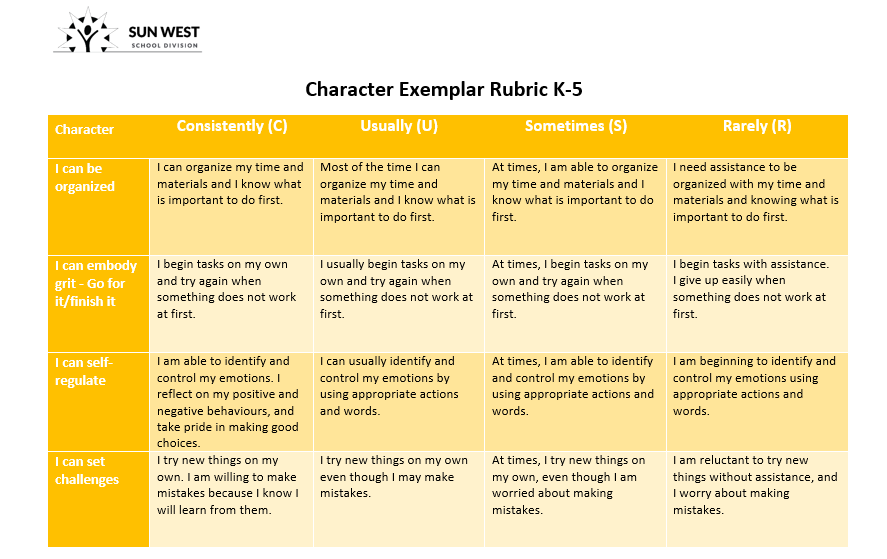
Character K-5
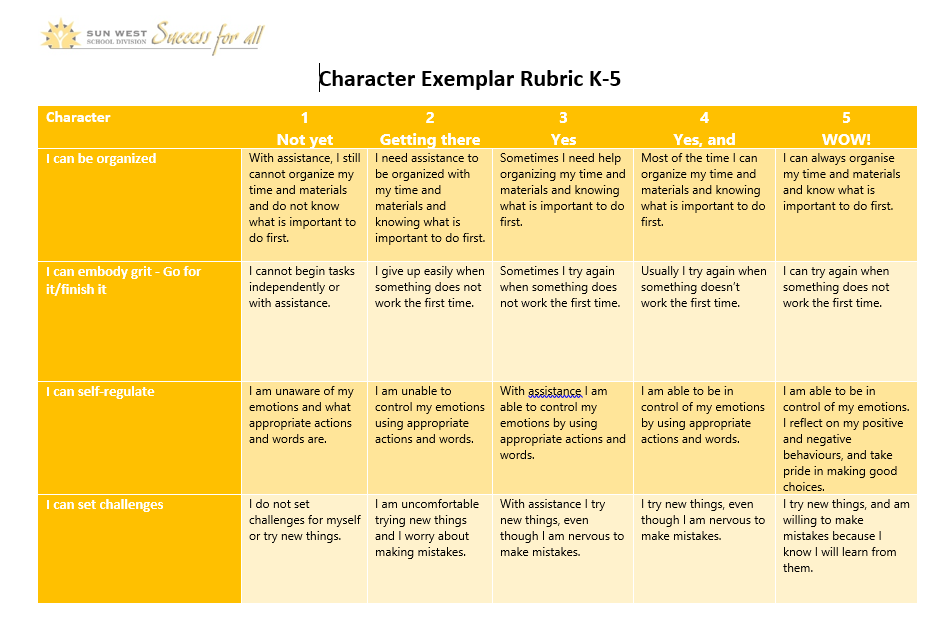
Character K-5 Exemplar Rubric
Co-creating Rubrics
Exemplar rubrics have been developed for K-5, 6-9 and 10-12. To connect fully with students in their understanding of skill application and growth, a recommendation would be to re-write the rubric with the students to include their understanding of the skill, goals for integration in learning and commitment to the skill development.
Resources
Letitripple Resource Hub (5,000+ curated resources to help develop character year-round) http://www.letitripple.org/character-day/education-hub/
Sun West Resource Bank Elementary Character Resources
Print based
Sun West Original Print Based Character K-5 Guidebook: CharacterGuidebook.docx
Book Be Organized: Over Scheduled Andrew – Ashley Spires
Books Grit:
· I Can Be Anything – Jerry Spinnely
· The Magnificent Thing—Ashley Spires
· Same and Dave Dig a Hole – Mac Barnett
Books Self-Regulate:
- Alexander and the Horrible, Terrible, Very Bad Day – Judith Voirst
- Alexander, Who is Trying to be the Best Boy Ever – Molly Bang
- My Mouth was a Volcano – Julia Cook
- When Sophie gets Angry, really, really Angry – Molly Bang
- Frog and Toad – Arnold Lobel
- Pete the Cat – James Dean
- Scardey Squirrel – Melanie Watt
See below for organizers, planners, and templates to help support teaching character traits in your classroom:
Grade 4 Math - Unit Organizers and Self-Reflections
Videos
| Class Dojo Growth Mindset Video Series
|
https://www.youtube.com/watch? v=2zrtHt3bBmQ&list=PL_UD9ElfNS 8NRw01pEqDuYcg4HeU2IamD |
| Carol Dweck- “The Power of Yet”
|
|
Angela Lee Duckworth- The Key to Success- Grit
|
|
|
Soar A Short Animated Video
|
https://www.youtube.com/watch?v=UUlaseGrkLc |
Interactive
Educational Articles
7 Tips for Building Character in Schools
How Character Education Helps Kids Learn and Develop
Web Sites
Understanding “Executive Functioning Skills”
|
http://blissfulkids.com
|
Website teaching students about Mindfulness strategies and a simple introduction to how their brain works.
|
|
https://www.understood.org/en/learning-attention-issues/child-learning-disabilities/executive-functioning-issues/5-ways-kids-use-working-memory-to-learn
|
Self-regulation is supported by a student’s working memory. Understanding our working memory can impact how we understand why some students may struggle with some parts of self-regulation. Closely working with your SST team is beneficial.
|
|
https://ed.ted.com/featured/nvJHP79R
|
“Don’t Eat The Marshmallow” Ted Talk - Joachim de Posada about delayed gratification. Lots of replicated activities developed for classrooms.
|
| https://www.youtube.com/watch?v= HyYhoCqo58w | “Brain-Based Learning”- Eric Jensen
|
